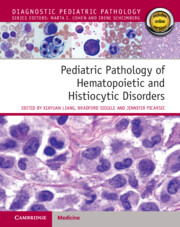Book contents
- Pediatric Pathology of Hematopoietic and Histiocytic Disorders
- Pediatric Pathology of Hematopoietic and Histiocytic Disorders
- Copyright page
- Epigraph
- Contents
- Contributors
- Section I General Hematology and Hematopathology
- Section II Non-Neoplastic Hematologic Disorders of Blood and Bone Marrow
- Section III Non-Neoplastic Disorders of Extramedullary Lymphoid Tissues
- Section IV Neoplastic Disorders of Bone Marrow
- Section V Mature Lymphoid Neoplasms
- Section VI Histiocytic Disorders and Neoplasms
- Chapter 24 Histiocytic Pathogenesis and Derivation
- Chapter 25 Identification of Macrophages and Dendritic Cells
- Chapter 26 Non-Neoplastic Accumulation of Histiocytes
- Chapter 27 Hemophagocytic Lymphohistiocytosis (HLH)
- Chapter 28 Histiocytic Inflammatory Neoplasms/Lesions
- Index
- References
Chapter 26 - Non-Neoplastic Accumulation of Histiocytes
from Section VI - Histiocytic Disorders and Neoplasms
Published online by Cambridge University Press: 25 January 2024
- Pediatric Pathology of Hematopoietic and Histiocytic Disorders
- Pediatric Pathology of Hematopoietic and Histiocytic Disorders
- Copyright page
- Epigraph
- Contents
- Contributors
- Section I General Hematology and Hematopathology
- Section II Non-Neoplastic Hematologic Disorders of Blood and Bone Marrow
- Section III Non-Neoplastic Disorders of Extramedullary Lymphoid Tissues
- Section IV Neoplastic Disorders of Bone Marrow
- Section V Mature Lymphoid Neoplasms
- Section VI Histiocytic Disorders and Neoplasms
- Chapter 24 Histiocytic Pathogenesis and Derivation
- Chapter 25 Identification of Macrophages and Dendritic Cells
- Chapter 26 Non-Neoplastic Accumulation of Histiocytes
- Chapter 27 Hemophagocytic Lymphohistiocytosis (HLH)
- Chapter 28 Histiocytic Inflammatory Neoplasms/Lesions
- Index
- References
Summary
The ontogeny of native Langerhans cells (LCs) in the epidermis has been debated over the past decade, with most agreeing that such LCs are now best classified as specialized resident-tissue macrophages derived from the embryonic yolk sac that have a self-renewal capacity in the steady state, along with migratory dendritic cell (DC)–like properties (albeit with much slower migration as compared to conventional or classic DCs [cDCs]) (1). The diversity of the epidermal pool of resident and inflammatory macrophages and DCs may be greater than previously realized – with LCs, monocyte-derived LC-like cells, and inflammatory dendritic epidermal cells (IDECs) all acting as human antigen-presenting cells (1).
- Type
- Chapter
- Information
- Pediatric Pathology of Hematopoietic and Histiocytic Disorders , pp. 312 - 319Publisher: Cambridge University PressPrint publication year: 2024



